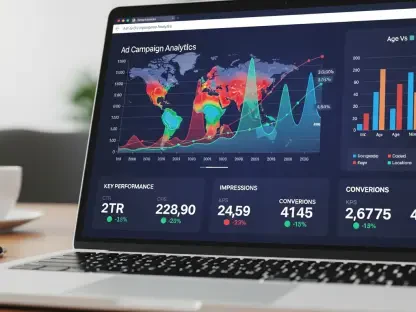Digital marketing strategies have evolved rapidly in the past few years. How we consume content was forever changed by social media and the rise of video content in recent years. However, artificial intelligence has been the leading cause of such rapid growth. In 2023 alone, 44% of marketers have used AI to produce content in some shape or form. People use AI not only because it’s cheap, but also because it’s incredibly scalable.
Facilitating Targeted Advertisements Through AI
While some argue that AI can generate personalized content, the truth is that machines cannot think or create anything new. AI can only regurgitate previously uploaded or scanned content but will never give you truly personal text. However, despite its inaccuracies, most firms are using it. They primarily use it to create content, like website copy (48%), social media images (39%), or sales pitches (33%), according to The State of GenAI Chatbots in Marketing, a study by Botco.ai.Besides copy, AI has proven to be a tremendous help for marketers who work under tight deadlines to analyze the market, track their demographic shopping habits, and create custom recommendations for them. Algorithms can provide quicker and more accurate tailored recommendations by following search history and purchase patterns.
Even though customers know cookies and Google crawlers track their behavior, that doesn’t seem to affect customer engagement, driven by tailored ads, no matter who makes them. The Capgemini Research Institute reports that 64% of consumers are willing to consider product recommendations generated by AI. Consequently, around 50% of marketers now leverage AI to create purchasing recommendations.
Optimizing Marketing Strategies through Predictive Analysis
Predictive analysis is one of the significant reasons why AI is so popular among business owners. In marketing, the algorithm quickly analyzes consumer behavior by examining email and social media website visits, which were hardly accessible just a few years ago, and marketers had to do it manually, relying on human analysis.
Now, in just a few clicks, algorithms examine large quantities of data and generate predictions in greater detail. That makes tailoring their messaging and analyzing consumer habits and preferences much more accessible for marketers, who can more effectively optimize their strategies to maximize success. One of the most significant updates in the ad targeting business is language recognition, a complex study on human behavior meeting the still rudimentary voice search optimization.
AI-fueled Voice Search
Artificial intelligence has become part of our everyday lives, from content and image creation to customer service and support, SEO and PPC, analytics, and email marketing automation. It is becoming part of the collegium. With the help of AI, voice search has also seen significant innovations, reshaping how businesses promote their products and services. In this article, we will explore precisely how AI-powered voice search will impact the future of digital marketing.
Voice Technology: Market Trends and Growth
Voice technology is not the science behind Adele’s voice but refers to AI-powered voice-based tools that elevate our user experience on the Internet of Things. According to Statista, voice technology is an expanding market that reached almost 12 billion dollars in the US in 2022.
- Last year, 90.7 million homes used smart speakers to search for content, about a third of the adult population (semrush.com).
- A study shows that 50% of people who stream content use voice commands to help find and view movies (variety.com).
- Over 58% of Americans use voice search, but the 18 to 34 age group is the most dominant (demandsage.com).
- 27% of people regularly use voice search on mobile (Barilla’s Voice Consumer Index).
- Voice search results tend to load 52% faster than the average search results (demandsage.com).
But voice apps are popular in many industries besides shopping, searching for fun facts, or downloading movies. Students actively use voice notes to help them memorize and recall their knowledge, and many companies employ speech-to-text dictation in their everyday practice. But how does a customer’s voice translate to targeted advertisements?
Language Recognition Upgrades
Since its early days, voice search has become more sophisticated and precise. In the beginning, Google Assistant recognized only a few languages, and anyone with an accent would see gibberish on their screen. Today, Google Voice Search supports 94 languages, Siri supports 17 languages, and Alexa supports 18 languages.
Voice search-powered AI and machine learning can now interpret human speech patterns and generate data predictions based on human input. Intelligent assistants like Alexa, Siri, and Google Assistant were designed to collect data from the human voice to develop more precise results over time.
The goal is to learn and adapt to their humans’ unique speech patterns, accents, and colloquialisms to provide a sophisticated, personalized service. People use voice to search more and more, which helps the algorithm adjust and increase accuracy. Here is how digital marketers who learn how to rely on voice-based tools can survive the voice search revolution.
Understand the Evolution of User Intent in Voice Search
Users have adapted to voice-first search quickly due to its hands-free nature. The appeal is that you can search for a show on your Smart TV while chopping onions and, at the same time, ask Siri to show you cheese casserole recipes. Perfect for multitasking or on-the-go personalities, voice search allows you to step away from the screen if needed or give your hard-working thumbs a rest.
This means marketers have witnessed a sudden shift from traditional keyword-focused and backlink-building SEO to rapidly evolving voice search optimization (SVO). Voice search engines are more attuned to natural language than strict professional or AI-generated content. VSO prioritizes spoken queries, so marketers are not just using a new technology. They need to evolve with it, and one of its most essential aspects is grasping the nuances of human behavior.
Typed vs. Voice Searches
So, for now, voice searches are your keywords. They just use a different medium. At the rate that this technology is growing, it is vital that we fully understand user intent. But long-tail keywords are challenging to track. The Google Search Console still cannot precisely determine whether someone is typing or recording their search, except it sometimes filters out exceptionally long keywords and favors those that are more in line with voice search user intent. But what we know about voice search optimization now includes the following:
- Microsoft Cortana finds that text-based searches are usually up to two words long. But besides the length of text searches, they have a more artificial language or computer language than very conversational voice queries.
- For example, a typed search could be something like “Tulum Mexico Travel Deals,” but a voice search has a more natural flow: “Show me the best travel deals for Tulum, Mexico in April.”
- The most commonly used angle when predicting user behavior is to focus on near-me voice searches.
Prioritize Natural Language in VSO
That is why optimizing your website for voice search is crucial. It increases your visibility and provides a better user experience, which ties into the sales funnel and fosters loyalty because it makes it more probable that satisfied users will return to a website again. To optimize your website for voice search, relying on keyword research tools is good, but remember, natural languages are the goal here. For example, instead of searching for the best burger in Austin, Texas, people usually search for phrases like “Cheap burger near me” or “Where can I find the best burger joint near me?”
Start thinking like your customer to ensure you get all the keywords and phrases. Put yourself in the shoes of an average person rushing from work to watch their favorite show and wondering where to find a yummy burger, and you’ll easily find your VSO keywords. It is important to note that websites should not completely switch from text-first to voice-first. While voice searches have leveled the field with text-based searches in just a few years, it doesn’t mean they will push out typing. Most people like the hands-free experience but cannot search out loud for most things in public.
More than 60% of people said they only use voice search at home or in the office alone. However, even the number of people comfortable using Voice Assistants in public is not that low: around 30% of users have used voice search in public transportation, and over 30% use it when alone in restaurants.
Improve UX Through Contextual AI Integration
AI-powered voice assistants have improved tremendously over the years and have a significant role in voice search. One of the most critical advancements in AI is understanding the context of a conversation.
For example, if you ask: “Who won the tennis match last night?” and follow it up with: “Who is he playing with in the quarter-finals?” – the AI assistant can connect these two questions and give you the correct answers without requiring context for the second one.
The ability of AI-powered assistants to understand the context of a query helps them to provide more accurate and relevant results, further improving the user experience and supercharging VSO.
Real-Time Insights: Monitoring and Improving Sales Funnels with AI
Voice search is changing the customer journey. Every time you visit a website, you might encounter a chatbot or a virtual assistant. These machines are top-rated tools for businesses that depend on customer support. The power of AI provides support instantly, streamlining the sales funnel and immediately alerting the organization when something is wrong with the conversion funnel. Artificial intelligence allows you to analyze your click-through rates and the point at which the customer clicks off in the shopping process. AI is also capable of multitasking.
For example, one page of your website answers frequently asked questions by many visitors, while some other parts are frictionlessly processing orders without human intervention. This is the aspect of business where AI is at its best because customers here don’t care about the human touch. They just want a high response time and an easy shopping experience.
Conclusion
The digital marketing landscape is one of the fastest-evolving ones. Marketers compete daily to stay ahead of the curve, trying to come up with a new angle on an old strategy – should we push more content out or less, which ads perform best, what is popular, and how are new content consumption patterns made – all just to stay afloat in the vast ocean of information that is digital marketing.
Merging machine learning with voice-first searches is a significant paradigm shift in businesses’ marketing strategies. We now have new ways to target and engage customers while providing a frictionless and personalized user experience. Predictive analysis and keyword research have evolved and become more sophisticated. Digital marketers will have to work hard to adapt to the fast pace of AI and capitalize on its tremendous potential.









